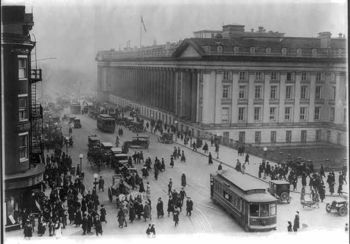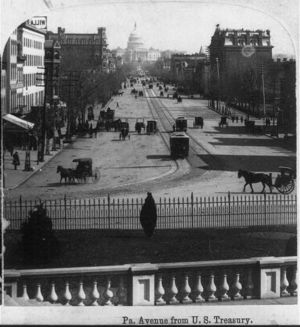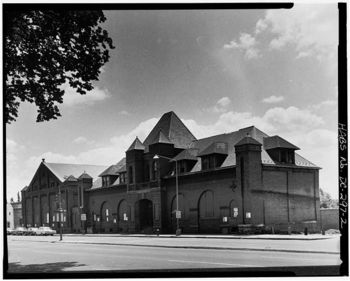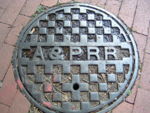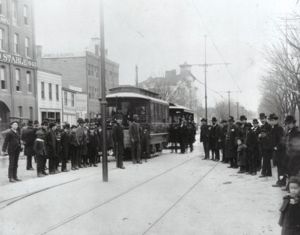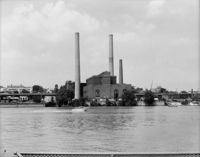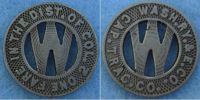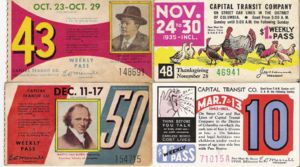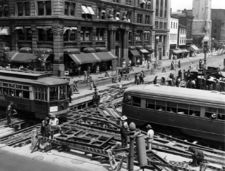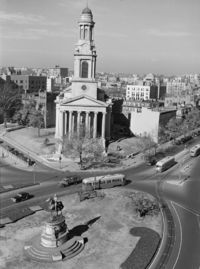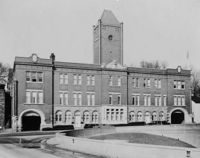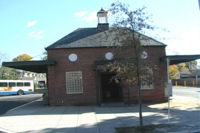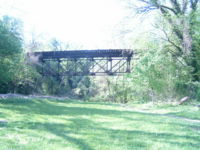Washington streetcars
For just under 100 years, between 1862 and 1962, Washington, D.C. streetcars and interurbans transported people across the city and region. The first streetcars in D.C. were drawn by horses, but later cable cars were used. By the beginning of the 20th Century, the streetcar system was fully electrified. A number of the District's streetcar lines were extended into Maryland, and a separate system was established for Northern Virginia. Over the years, the various companies were party to numerous mergers and bankruptcies, until all of the streetcars were part of one company, Capitol Transit. Labor strife, the popularity of the automobile and pressure to replace the streetcars with buses led to their demise. In January of 1962 the last car went on its last run. Elements of the system still remain as roads, bus barns, Metrobus depots, rail trails and unused abandoned infrastructure.
Contents
- 1 District of Columbia Network
- 1.1 Washington and Georgetown Railroad Company
- 1.2 Metropolitan Railroad Company
- 1.3 Columbia Railway Company
- 1.4 Anacostia and Potomac River Railroad Company
- 1.5 Capitol, North O Street and South Washington Railway Company
- 1.6 Eckington and Soldiers’ Home Railway Company
- 1.7 Brightwood Railway Company
- 1.8 Georgetown and Tenallytown Railway Company
- 1.9 Rock Creek Railway
- 1.10 The Washington & Great Falls Electric Railway
- 1.11 Capital Railway Company
- 1.12 The East Washington Heights Traction Railroad
- 1.13 Washington Railway and Electric Company & Capital Traction Company
- 1.14 Capital Transit Company
- 1.15 DC Transit
- 2 Suburban Maryland
- 3 Northern Virginia
- 4 Interurbans
- 5 Technology
- 6 Trolley parks
- 7 Appearances in motion pictures
- 8 Remnants of the system
- 9 See also
- 10 References
- 11 Notes
- 12 External links
District of Columbia Network
Washington and Georgetown Railroad Company
Chartered on May 17, 1862[1], during the American Civil War, to build three street horsecar lines using the same track gauge as the Baltimore and Ohio Railroad (Standard gauge). The first streetcars were installed on Pennsylvania Avenue from Georgetown to the Washington Navy Yard.
The first day of operation was July 29, 1862, and the entire system was completed on November 15. Later, lines were built along 7th Street and 14th Street. The system was so successful, that the initial three lines were extended and new lines were built.
In 1865, Sojourner Truth successfully led the fight to allow blacks to ride freely on Washington's streetcars. The streetcars were one of the few places in Washington free from racial segregation.
After switching to cable cars in 1890 it was acquired by the Rock Creek Railway in 1895 and the new company was named the Capital Traction Company.
In 1897 Capital Traction built the Georgetown Car Barn ("Capital Traction Company" is still written above the main door).
Remnants of the line
- The Georgetown Car Barn at 3600 M Street, NW. Like the East Capital Street Car Barn it was designed by Waddy B. Wood. The "Exorcist Steps" were built as part of the car barn's construction. They connect Prospect Street to M Street. The building is now owned by Douglas Development and leased to Georgetown University.
- The facade of the Washington & Georgetown car barn at 3222 M Street, NW, now the main entrance to The Shops at Georgetown Park The car barn was previously the stables for Gilbert Vanderwerken's omnibus line. It was purchased by the Washington & Georgetown line and used first as stables.
- The "Blue Castle" or Navy Yard Car Barn at 770 M Street, SE. It's now the home of the KEY Academy, Washington Math Science Technology Public Charter School, and the Eagle Academy. See photo on this page. The building was purchased in January 2006 by Preferred Real Estate Investments who intend to change its color and turn it into retail space. Further information in Washington Post story.
Metropolitan Railroad Company
Incorporated in 1864. Its first line ran from the Capitol to the War Department via F Street, NW. Later lines ran along Connecticut Ave; 7th St, NW; E. Capitol St; from Dupont Circle to Georgetown via the P Street Bridge and along O & P Streets in Georgetown. In 1896 Metropolitan built the Waddy B. Wood designed East Capitol Street Car Barn and in 1899 merged with the Washington Traction and Electric Company, which quickly went bankrupt. It was then purchased by the Washington Railway and Electric Company.
Remnants of the line
- The East Capitol Street (or Lincoln Park) Car Barn at 1400 East Capitol Street, NE, now a condominium.
- Visible train tracks in the center of O and P Streets in Georgetown
Columbia Railway Company
Founded in 1870. It started opearations in 1872 at New York Avenue NW and 15th St NW, and ran east along New York Avenue NW to K Street NW, along K Street NW to Massachusetts Avenue NW, along Massachusetts Avenue NW to H Street, NW, and along H Street to Benning Road NE (formerly Columbia Pike). On October 28, 1895, it converted to a cable car system. In 1898, the route was extended out Benning Road, NE, to the Deanwood neighborhood. This extension was built as an electric line, and in 1899, the rest of the cable car line was converted to electricity. From Deanwood, passengers could transfer to the Chesapeake Beach Railroad or the Washington, Baltimore and Annapolis Railroad both of which stopped at Seat Pleasant just outside the District. It eventually became part of the Washington Railway and Electric Company.
Anacostia and Potomac River Railroad Company
Incorporated in 1872. In 1875, it constructed a streetcar line across the Anacostia River. The line ran from 7th Street and M Street SW, along M Street and 11th across the Navy Yard Bridge (now the 11th Street Bridge) to Uniontown (now historic Anacostia). The route then ran down Nichols Avenue (now Martin Luther King Avenue) to V Street SE. A car barn and stables were maintained by the company at Nichols Avenue and V Street SE. It eventually became part of the Washington Railway and Electric Company.
Capitol, North O Street and South Washington Railway Company
Incorporated and opened in 1875. It operated streetcar lines primarily on NW 4th St. and NW 11th St. In 1893 it was renamed the Belt Railway Company, and in 1899 it was acquired by the Anacostia and Potomac River Railroad Company. See a photo here.
These lines were later converted to electric operation. The last horsecar ran on May 26, 1900.
Eckington and Soldiers’ Home Railway Company
The first electric streetcar in D.C. was run by the Eckington and Soldiers' Home Railway. It was chartered on June 19, 1888 and started operation later that year. It started at 7th & New York Ave. NW, east of Mount Vernon Square and travelled a distance of 2 ½ miles to the Eckington Car barn at 4th and T NE via Boundary Street, Eckington Place, R Street, 3rd and T Street. A one week pass cost $1.25. In 1889 it was extended to Glenwood Cemetery and in 1895 to Soldiers' Home. The Glenwood Cemetery extension was shut down in 1894. In 1898, it merged with the City and Suburban Railway.
Remnants of the line
- The Eckington Car Barn at T Street, NE, between 4th and 5th Streets; now a postal facility
Brightwood Railway Company
On October 18, 1888, Congress authorized the Brightwood Railway Company to build a streetcar line on Georgia Avenue (then known as Seventh Street Extended or Brightwood Avenue) from Boundary Street to the District line at Silver Spring. Four of the five founders were partners in the Petworth subdivision, including the line's president, A. A. Thomas.
The Metropolitan Railroad Company had run a horse-drawn line on Georgia Avenue to Rock Creek Church Road since about 1873. The Metropolitan was authorized to run the streetcar line all the way to the District boundary, but the area was sparsely developed and the horsedrawn cars offered a long, slow trip to and from the city. Business was slow. So the Brightwood Railway Company bought the Metropolitan's Georgia Avenue line in 1890 and electrified it. Because all wiring in the city was required to be underground the line used storage battery cars. Maximum fare was 5 cents/passenger or 6 tickets for 25 cents.
The Brightwood line was extended to Takoma Park in 1892. In 1895 the Washington, Woodside and Forest Glen Railway and Power Company was organized to carry the Brightwood line into Montgomery County.
Remnants of the line
- The Brightwood Car Barn, 5929 Georgia Avenue, NW; parts were incorporated into Curtis Chevrolet
Georgetown and Tenallytown Railway Company
The Georgetown and Tenallytown Railway Company was chartered in 1888 and had electric lines running along Wisconsin Avenue to the District line in 1890. In 1897, the line merged with the Tenallytown and Rockville Railroad, which ran to Alta Vista and Rockville. Together they formed the Washington and Rockville Electric Railway Company. The new company was purchased by the Washington Railway and Electric Company in 1902. In 1935, it converted to buses.
Rock Creek Railway
Starting in 1890 it ran between the Cardoza/Shaw neighborhood and Chevy Chase Lake in Maryland. It started at 7th & Boundary Street, traveled east on Florida, U Street, north on 18th Street, west on Calvert Street, and north on Connecticut Avenue to Chevy Chase Lake. It was built by the Chevy Chase Land Company, whose principal owner was Francis G. Newlands. On September 21, 1895, the Rock Creek Railway acquired the Washington and Georgetown Railroad Company. The new company was named the Capital Traction Company.
Remnants of the line
- The Decatur Street Car Barn at 4701 14th Street, NW. Also known as the Capital Traction Company Car Barn, it is now a Metrobus barn.
The Washington & Great Falls Electric Railway
Incorporated in 1892 and opened in 1895, The Washington & Great Falls Electric Railway began in Georgetown at 36th and Prospect Streets and ran in a private right-of-way along the lands of the Washington Aqueduct to Glen Echo and from there along the old tracks of the Glen Echo Railroad to Cabin John. Because the railroad never reached Great Falls, but instead terminated at Cabin John, it was often referred to as the "Cabin John Trolley". It was acquired in 1902 by the Washington Railway and Electric Company. The railway was dismantled in the 1960s, but the former roadbed is still discernable in The Palisades and in Montgomery County, Maryland. More details and photos are available at this website.
Remnants of the line in Washington, D.C.
- Trestle over Arizona Avenue, NW, between Dorsett Place and Sherier Place
- Trestle over Foundry Branch in Glover Archibald Park, near Georgetown University
Capital Railway Company
The Capital Railway Company was the first electric railway line to cross the Anacostia. It was incorporated in 1895 and ran over the newly constructed bridge at Pennsylvania Avenue and along Nichols (now Martin Luther King) Avenue past St. Elisabeths. In 1900 it was sold to the Anacostia and Potomac River Railroad. By 1902, the streetcar line had been extended along Nichols Avenue to Congress Heights, ending at Upsal Street. In 1935 it was converted to buses.
The East Washington Heights Traction Railroad
Opened sometime after 1900 and ran on Pennsylvania Avenue, SE, across the Anacostia River on the bridge that was replaced by the John Philip Sousa Bridge. In 1923, it became the first streetcar in D.C. to convert to buses.
Washington Railway and Electric Company & Capital Traction Company
In 1900, Congress passed the Reorganization Act. This paved the way for an extensive series of mergers and acquisitions, through which ownership of all streetcars in Washington was divided between two companies: the Washington Railway and Electric Company' and the Capital Traction Company. The Washington Railway and Electric Company had been formed in 1900 for just this purpose. The combined system reached its greatest size in 1915.
In 1925, the North American Company acquired, through stock purchase, a controlling interest in the Washington Railway and Electric Company and a minority interest in Capital Traction. At about this time, the system (as in other cities) began to decline in quality and ridership because of competition from the private automobile and buses. At the time, streetcars were viewed by many as old fashioned, impractical and less desirable than buses. With the coming of the Depression, revenues and maintenance suffered. Unlike today, most transit systems were privately owned and received no government subsidy.
Remnants of WREC
Capital Transit Company
In December 1933, the Washington Railway and Electric Company merged with Capital Traction forming the Capital Transit Company. For the first time, all street railways in the Washington were under the same management.
On August 28, 1937, the first PCC streetcar entered service in Washington on 14th Street. Over the next two years, Capital Transit would replace all cars with the PCC model.
On September 12, 1949, Louis Wolfson purchased from North American 45.61% of the company's stock for $20 per share. The sale allowed North American to comply with the Public Utility Holding Company Act of 1935, which prevented North American from owning other businesses along with the Potomac Electric Power Company. This came about after a decision by the United States Supreme Court in North American Company v. Security and Exchange Commission in 1946.
On December 14, 1949, the Connecticut Avenue trolley stop and tunnel were built under Dupont Circle as a step in moving the entire streetcar system underground. The idea never caught on.
Remnants of the system
- Connecticut Avenue tunnel under Dupont Circle and abandoned underground station
DC Transit
In 1956, in response to a carmen's strike, Congress and the District Commissioner revoked Capital Transit's franchise. [1] The franchise was sold to O. Roy Chalk, a New York financier who owned controlling interest in Trans Caribbean Airways. He purchased the assets of Capital Transit under the corporate title of DC Transit. Part of the agreement was that he would eliminate the streetcars and replace them with buses. Streetcar service ended on January 27, 1962, and most of the cars were sold to Barcelona and Sarajevo.
Most of DC Transit's assets were purchased by the Washington Metropolitan Area Transit Authority (WMATA) in 1973.
Suburban Maryland
Northern Virginia
Interurbans
Technology
The first streetcars were pulled by horses. Later, cable cars were used. By 1900, all trains were powered by electricity.
Horsecars (1862–1900)
See Horse car
Cable cars (1890–1899)
As was true in many US cities at the end of the 19th century, cable cars briefly ran down D.C. streets. They were run by two existing streetcar companies. In 1890, the Washington and Georgetown Railroad Company converted to cable cars and built the Navy Yard Car Barn for that purpose, but on September 29, 1897, the company's powerhouse at 14th St. and Pennsylvania Avenue NW burned down. An electric conduit car system replaced the cable cars the next year. The Columbia Railway Company also operated cable cars before converting to electrical operation. It ran them between October 28, 1895 and 1899.
Electric cars (1888-1962)
In the downtown area overhead wires were forbidden on the streets, so standard trolley cars could not be used. But outside of downtown an underground conduit system was too expensive to build. To meet both needs, an unusual dual system of power supply was utilized.
In downtown, the cars acted as conduit cars. Electrical power was delivered to the cars by way of an underground delivery system. This is similar to a "third rail" system though it's technologically different. A conduit slot was located between the two riding rails and the streetcar drew power from this mechanism through a plow. The plow was an electrical contact which was attached to the underside of the carriage and extended more than one foot beneath the surface of the street through a slot running down the middle of the track. This technology was initially used in Blackpool, but later only in Washington, Manhattan, and London.
In the outer areas and for interurban travel, the streetcars acted as trolley cars. At the outskirts of downtown, the cars would stop at a plow pit, a manned space under the tracks, where the plow could be removed by the pitman. At the same time, the conductor would attach the trolley pole to the overhead wires and switch to overhead power. See photo of a plow pit here.
Trolley parks
- Suburban Gardens
- Luna Park
Appearances in motion pictures
- The Day the Earth Stood Still
- Mr. Smith Goes to Washington
- Sherlock Holmes in Washington
Remnants of the system
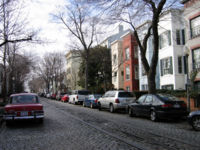
- Stations
- 14th Street and Colorado Avenue, NW, now a Metrobus depot
- 1900 block of Calvert Street, NW, now a Metrobus depot. The white building now standing was a Toddle House restaurant. See further information here.
- Connecticut Avenue and Northampton, NW, now a Metrobus depot
- Tunnels
- C Street between New Jersey Avenue, NW, and Delaware Avenue, NE
- Turnaround loop under 14th Street, SW, south of C Street
See also
References
- Carlson et. al. (1986), The Colorful Streetcars We Rode, Bulletin 125 of the Central Electric Railfans' Association, Chicago, Il. ISBN 0-915348-25-X
- Harwood, Herbert Hawley (2000). Rails to the Blue Ridge: The Washington and Old Dominion Railroad, 1847–1968. ISBN 0-615-11453-9.
- King, Jr., Leroy O. (1972). 100 Years of Capital Traction. Taylor Publishing. Template:LCC.
- Kohler, Peter C. (2000). Capital Transit: Washington's Street Cars, the Final Era 1933–1962. ISBN 0-9712936-0-0.
- Markwood, Louis N. (1975). The Forest Glen Trolley and the Early Development of Silver Spring. Template:LCC.
- Merriken, John E. (1987). Old Dominion Trolley Too: A History of the Mount Vernon Line. ISBN 0-9600938-2-6. Template:LCC
- Merriken, John E., King, Leroy (1993). Every Hour on the Hour: A Chronicle of the Washington, Baltimore and Annapolis Electric Railroad. ISBN 0-9600938-3-4.
- Merriken, John E (1965). Annapolis Short Line: the Big Red Cars. Template:LCC.
- Molter, Nelson J (1969). An Illustrated History of Severna Park, Anne Arundel County, Maryland, the Annapolis Short Line & W.B. & A. Railroads. Template:LCC.
- Stanton, Thomas E., Truax, Robert A. (1983). The Street Railway Post Offices of Washington, D. C.. Mobile Post Office Society.
- Wagner, Charles M (1951). A Pictorial History of the Washington, Baltimore & Annapolis Electric Railroad. Template:LCC.
- Williams, Ames W (1989). The Washington and Old Dominion Railroad. ISBN 0-926984-00-4.
- Williams, Ames W (1981). The Chesapeake Beach Railway: Otto Mears Goes East, 2nd edition.
Notes
- ↑ Journal of the House of Representatives of the United States, 1861-1862 (July 2, 1862). Retrieved on 2006-12-04.
External links
- National Capital Trolley Museum
- A memorial site for D.C. Transit
- D.C. Transit page at www.clouse.org
- D.C. streetcar photos at Dave's Rail Pix
- Online exhibit of Washington streetcars from the National Museum of American History
- Washington D.C. Transit by Chicago Rail Fan
- Information on the underground conduit system
- Looney v. Metropolitan Railroad Co, a 1906 United States Supreme Court case regarding the death of a pitman
- Article about the history of the Georgetown car barn
- Article on the train tracks in Georgetown
- Article on the last days of D.C.'s streetcars
- Washington, D.C., Railroad History at the National Railway Historical Society
- NYCSubway.org: Washington D.C. Streetcars
- Photos of streetcars on Barracks Row in Southeast
- A Brief History of the Georgetown Branch of the Baltimore and Ohio Railroad. Contains information on Washington's streetcar system as well.
- 1908 streetcar map
- Caroling Streetcars
